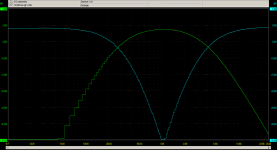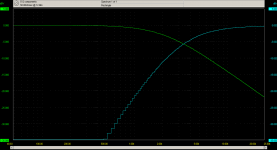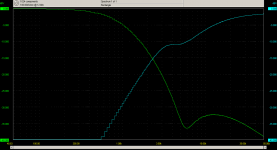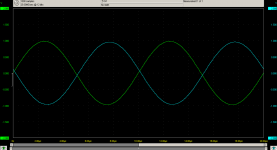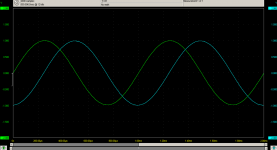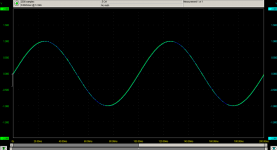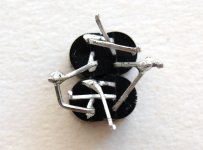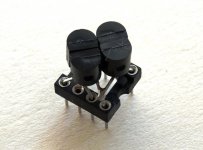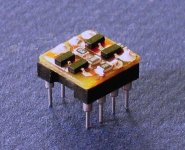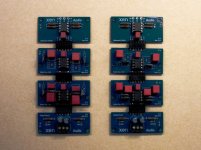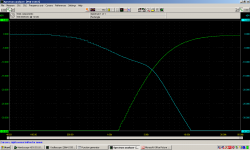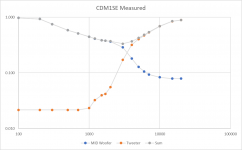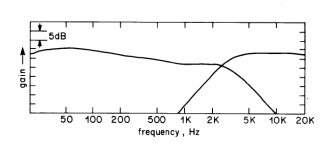A good friend in Germany is a loud speaker builder. He has recently been totally hooked on active crossovers using the popular Mini-DSP. The digital solution is of course very convenient. One can just change the crossover characteristics on a laptop, check the total response in software based on measured chasses frequency responses, and then write it to the DSP. And we can immediately listen to the result / changes within minutes. A direct A-B test of two different crossover designs becomes possible.
But once settled on a final design, we wish to convince him that analogue filters sound better.
John Curl's Blowtorch preamplifier part II - Page 9870 - diyAudio
John Curl's Blowtorch preamplifier part II - Page 9870 - diyAudio
We were looking for a modular active crossover filter system where we can combine different basic filter elements as described by Linkwitz, for example.
Active Filters
In particular, we do not wish to use DIP switches in the signal path, and we wish to be able to vary the number of elements in series as we wish. After searching the net for solutions / examples, we found nothing suitable, and ended up designing our own.
You can read about our solution in the attached PDF article.
Happy reading,
Patrick
.
But once settled on a final design, we wish to convince him that analogue filters sound better.
John Curl's Blowtorch preamplifier part II - Page 9870 - diyAudio
John Curl's Blowtorch preamplifier part II - Page 9870 - diyAudio
We were looking for a modular active crossover filter system where we can combine different basic filter elements as described by Linkwitz, for example.
Active Filters
In particular, we do not wish to use DIP switches in the signal path, and we wish to be able to vary the number of elements in series as we wish. After searching the net for solutions / examples, we found nothing suitable, and ended up designing our own.
You can read about our solution in the attached PDF article.
Happy reading,
Patrick
.
Attachments
Last edited:
Here the links to the references in the article :
1a. http://xen-audio.com/documents/accuton/130701 Accuton CELL Public.pdf
1b. http://xen-audio.com/documents/accuton/130818 Accuton CELL Public 2.pdf
2. Hifi-Selbstbau - DUO-DXT
3. Active Filters
4. Crossovers
5. http://www.musicanddesign.com/Duelund_and_Beyond.html
6. https://www.stereophile.com/standloudspeakers/630/index.html
Patrick
1a. http://xen-audio.com/documents/accuton/130701 Accuton CELL Public.pdf
1b. http://xen-audio.com/documents/accuton/130818 Accuton CELL Public 2.pdf
2. Hifi-Selbstbau - DUO-DXT
3. Active Filters
4. Crossovers
5. http://www.musicanddesign.com/Duelund_and_Beyond.html
6. https://www.stereophile.com/standloudspeakers/630/index.html
Patrick
The all-pass delay module was tested on its own.
I do not have a network analyser to demonstrate the phase response of the all-pass delay filter.
So here are the time domain responses of a 1kHz all-pass, at 10Hz, 1kHz, and 100kHZ respectively.
Also note the DIP male and female headers which, if so wish, will allow quick-change plug & play.
Patrick
.
I do not have a network analyser to demonstrate the phase response of the all-pass delay filter.
So here are the time domain responses of a 1kHz all-pass, at 10Hz, 1kHz, and 100kHZ respectively.
Also note the DIP male and female headers which, if so wish, will allow quick-change plug & play.
Patrick
.
Attachments
For discrete JFET source follower buffers, you can refer to an earlier article for the choice of JFETs :
NJFETs for Source Follower Applications
Patrick
NJFETs for Source Follower Applications
Patrick
Hello Patrick,
Congratulation: those dual FET Buffers on IC feet are a gem.
And not only that: the DuoDXT circuit is very, very nice, - finally!-taking intrinsic driver SPL characteristics into consideration. Only this approach will yield proper acoustic transfer functions, instead of the usual mistake of using textbook filter slopes in active analogue filters.
Question: Should there not be a buffer/signal splitter before the filter sections?
Kind Regards,
Eelco
Congratulation: those dual FET Buffers on IC feet are a gem.
And not only that: the DuoDXT circuit is very, very nice, - finally!-taking intrinsic driver SPL characteristics into consideration. Only this approach will yield proper acoustic transfer functions, instead of the usual mistake of using textbook filter slopes in active analogue filters.
Question: Should there not be a buffer/signal splitter before the filter sections?
Kind Regards,
Eelco
> those dual FET Buffers on IC feet are a gem.
Cannot beat P2P direct wiring. 🙂
Incidentally, using 2SK209GR, once can also make a dual channel chip version, similar to this from 2009 :
B1-Turbo on a Chip
> instead of the usual mistake of using textbook filter slopes in active analogue filters.
They work is all the chasses are broad band enough (quasi-full-range).
But then if they really are full-range, one can just cross using first order.
> Should there not be a buffer/signal splitter before the filter sections?
Every section is preceeded by a 22k input potential divider, followed by JFET follower or opamp.
So even up to 3-Way, input impedance of the combined crossover is still only ~7k.
I think most source / preamp should have no problem with that.
I have a few more elements on the drawing board (Linkwitz Transform, Variable BSC, ...)
But at this moment no immediate need, so yet to be tested.
Patrick
Kind Regards,
Eelco
Cannot beat P2P direct wiring. 🙂
Incidentally, using 2SK209GR, once can also make a dual channel chip version, similar to this from 2009 :
B1-Turbo on a Chip
> instead of the usual mistake of using textbook filter slopes in active analogue filters.
They work is all the chasses are broad band enough (quasi-full-range).
But then if they really are full-range, one can just cross using first order.
> Should there not be a buffer/signal splitter before the filter sections?
Every section is preceeded by a 22k input potential divider, followed by JFET follower or opamp.
So even up to 3-Way, input impedance of the combined crossover is still only ~7k.
I think most source / preamp should have no problem with that.
I have a few more elements on the drawing board (Linkwitz Transform, Variable BSC, ...)
But at this moment no immediate need, so yet to be tested.
Patrick
Kind Regards,
Eelco
Nice! I really like the jfet buffers p2ped to fit an 8 pin IC socket! I was thinking about doing a revised design of my synergy crossover to work with IC's instead of 2sk170's and what you have done allows either! 😎
Tony.
Tony.
> I really like the jfet buffers p2ped to fit an 8 pin IC socket!
That was a quad of 2SK369Vs done in 2011. 😉
Today I probably prefer 2SK117 / 2SK209.
With high source impedance as in the filters, they have lower distortion especially at high frequencies.
Patrick
.
That was a quad of 2SK369Vs done in 2011. 😉
Today I probably prefer 2SK117 / 2SK209.
With high source impedance as in the filters, they have lower distortion especially at high frequencies.
Patrick
.
Attachments
B&W CDM1 SE
A friend wanted to have his B&W CDM1 SE converted to (balanced) active crossover.
The crossover for the SE is quite different from the original CDM1.
So the frequency responses (voltages) at the tweeter and the main driver were first measured.
Then simulated, before building.
As can be seen, the matching to the original passive crossover is quite good.
🙂
Patrick
.
A friend wanted to have his B&W CDM1 SE converted to (balanced) active crossover.
The crossover for the SE is quite different from the original CDM1.
So the frequency responses (voltages) at the tweeter and the main driver were first measured.
Then simulated, before building.
As can be seen, the matching to the original passive crossover is quite good.
🙂
Patrick
.
Attachments
Hello Patrick,
As much as I admire your magnificent work, this approach to mimick the LS5/9 is -most likely- not going to work, although I may misunderstand your approach.
What we need is not the transfer functions of the low- and high pass filters as such, but the exact acoustic in-box transfer functions of woofer+tweeter and their associated LP and HP filters. With a suitable 20 cm woofer and suitable tweeter, the filter connected to the drivers in box should then be optimized to mimick the exact acoustic transfer functions of the LS 5/9 w+tw. But maybe you already realized that, and I am thus barking to the wrong tree.
This may be a nice design for nostalgic reasons, but a 20 cm polycone woofer with a regular 30 mm or so dome, without a waveguide, and then x/o-ed @2.5-3kHz-ish, plus very sharp baffle edges, is not something to get excited about anno 2020.
As much as I admire your magnificent work, this approach to mimick the LS5/9 is -most likely- not going to work, although I may misunderstand your approach.
What we need is not the transfer functions of the low- and high pass filters as such, but the exact acoustic in-box transfer functions of woofer+tweeter and their associated LP and HP filters. With a suitable 20 cm woofer and suitable tweeter, the filter connected to the drivers in box should then be optimized to mimick the exact acoustic transfer functions of the LS 5/9 w+tw. But maybe you already realized that, and I am thus barking to the wrong tree.
This may be a nice design for nostalgic reasons, but a 20 cm polycone woofer with a regular 30 mm or so dome, without a waveguide, and then x/o-ed @2.5-3kHz-ish, plus very sharp baffle edges, is not something to get excited about anno 2020.
> the filter connected to the drivers in box should then be optimized to mimick the exact acoustic transfer functions of the LS 5/9 w+tw.
I have no reason to doubt that BBC Research has not done that properly, years ago.
Maybe you have already read their research paper on the LS 5/9 as well as LS 5/8.
Then you should know on which my Spice file were based.
It is also not my speaker.
I was just interested in the filter exercise.
And there are still many people who love their LS5/9.
We are all free to exercise our individual choice.
Cheers,
Patrick
I have no reason to doubt that BBC Research has not done that properly, years ago.
Maybe you have already read their research paper on the LS 5/9 as well as LS 5/8.
Then you should know on which my Spice file were based.
It is also not my speaker.
I was just interested in the filter exercise.
And there are still many people who love their LS5/9.
We are all free to exercise our individual choice.
Cheers,
Patrick
- Home
- Source & Line
- Analog Line Level
- A Modular Analogue Active Crossover Filter Solution

